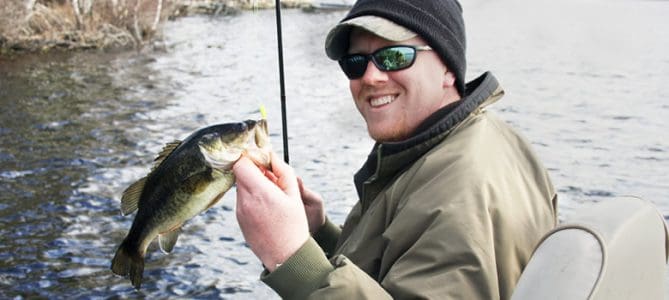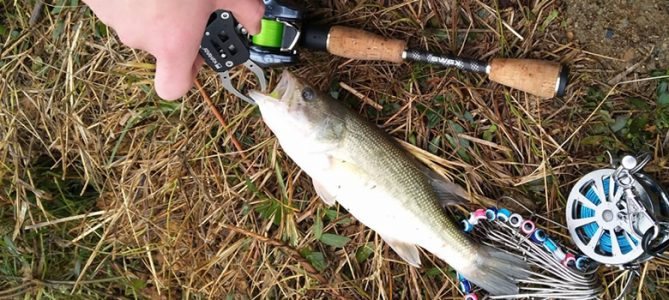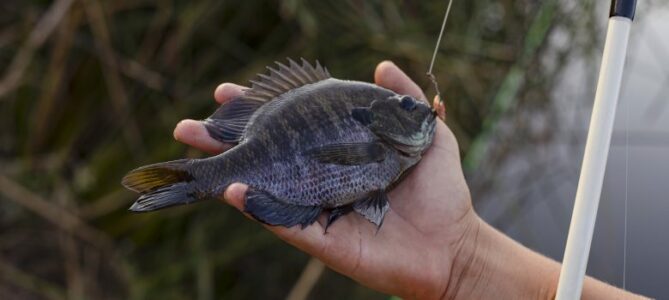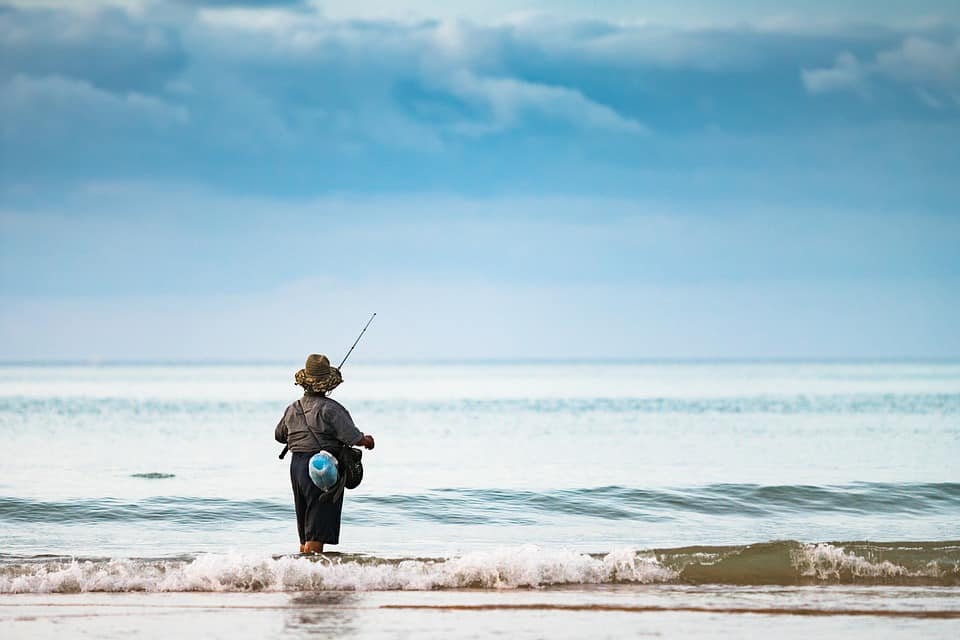If you buy via a link on this page, we may receive a commission, at no extra cost to you.Learn more
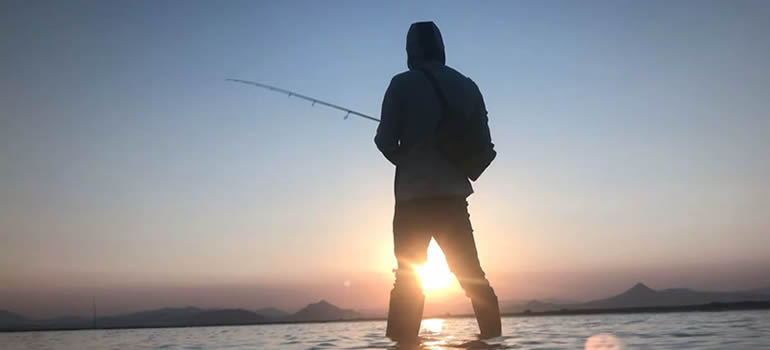
Trout can be finicky beasts during the day. Make one wrong move, and you’ll not only spook one, but you’ll also spook every trout for the next three holes down as he hurriedly scurries on past. Other times, the biggest trout are hiding so far under the bank, your little nymph isn’t enough to coax him out of his hidey-hole. At night though, everything changes.
Studies have shown that a large trout may swim up to four miles per night in search of a hearty meal. They do this so that they’ll be stuffed and satisfied during the day. With these monsters on the prowl, it’s the perfect time for you to go out and catch the trout that have eluded you during the day. The added benefit of fishing at night is the fading light. This gives you an extra advantage over the trout, who are more prone to make mistakes in the bait they go after.
Using this guide, you will be fully prepared to head out at dusk and slay some hungry trout. Below you’ll find out where to target the trout, what lures to use, what gear to bring, and what techniques to put in your arsenal. While you are best off using a fly-rod and reel in most cases when targeting trout, there are advantages to using a spin rod instead. This guide will focus specifically on how to spin for trout at night.
Step 1: Deciding Where to Target the Trout
Since you’ll be fishing in the dark, you want to go to a spot that you know well. This should be a spot where you know the fish are during the day, because chances are, they’ll be there at night as well.
You also want to pick a familiar area, especially if you’re going to be wading into the water. The last thing you want to do when night fishing is to wade into an area with a submerged log, or steep drop-off because it could lead to you tripping and falling into the water. Not fun during the day, and even less fun at night. Not only will you spook all the fish in the area, but you also won’t have any sun to dry yourself off. If you fall into the water while night fishing, you can pack up your gear and head straight home.
Trout at night are often in the shallows and will stay close to the bank. If you’ve caught trout along a particular bank before, make sure to hit that spot again at night, and don’t be shy about putting several casts onto the hole. If you see a rise, meaning the surface of the water is broken, target that area with a quick cast as well because it’s likely that trout are feeding there.
Look for sunken logs. Brown trout will often be hanging out near structure such as this. Large boulders are also one of the best spots to find a big trout lurking for its next meal. Also, target all shallow weedy areas with top-water bait and spinners.
One of the advantages you have using a spinning rod is the ability to cast farther than with a fly-rod. Take advantage of this by hitting every possible spot you can think of where a trout would be hiding out before moving on to your next fishing hole.
Step 2: Best Bait to Use at Night
Night fishing is all about making sure the trout notice your lure and identify it as their next potential meal. At night, bigger predators are patrolling the water, which allows you to use larger bait in the hopes of hooking a big old lunker.
Spinnerbaits and Poppers
Spinnerbaits and poppers work well at night, but especially under a full moon. In the moonlight, the poppers show up better on the surface of the water. Big trout like to lurk deep and feed upwards, looking for their meal cruising above them. The moonlight will illuminate your spinnerbaits, causing the blades to flash.
Put a Glass Bead Above a Tungsten Weight
- Package length: 12.7 cm
- Package width: 6.35 cm
- Package height: 1.524 cm
If you don’t have the benefit of a full moon to illuminate your lure, you want to attract the trout with noise. For those submerged trout deep down, a tungsten weight will bring your bait to the strike zone. Tie the glass bead above the weight. If you vary your retrieve, you’ll cause the glass bead to move up and down the line, making a clicking sound when it hits the weight.
Buying the beads separately will let you choose the right size of tungsten weight, depending on how deep you want your lure to get. An excellent option at Amazon is Brad’s Beads. A simpler alternative is to buy the full bead and weight rig pre-packaged together. You can check out the price of a 6-pack of pre-packaged Bullet Weights here.
Streamers Work Wonders
Big trout love to hit streamers like wooly buggers, and these work exceptionally well at night when the big boys are hunting. Streamers are usually best with a fly-rod as you can strip in your line giving the big bugger beautiful action in the water. But streamers can also be useful with a spinning rod. While you can’t necessary strip the line in, if you drag your wrist forward, you can give the streamer the same type of action you achieve by stripping it.
I prefer using a streamer with a spinning reel rather than with a fly-rod. The reason for this is it can be difficult to correctly set the hook when stripping in line because your hands aren’t working in unison. I find it much easier to set the hook and bring in a fish with the better control that comes with a spinning reel.
Use a Mouse Pattern on Skinny Water
A top-water mouse pattern may not have a high rate of success, but when a trout does strike, it’s always a big fish. Mouse patterns are more successful on skinny water because any trout in the water at the time will notice it. Target the bank and don’t reel, twitch the mouse upstream as close to the bank as you can. You may not get a strike, but if you do, it will be well worth your time.
Ideally, there will be a large rock or log in the middle of the water. Direct your mouse towards the structure and move it faster as it approaches. This will imitate a mouse fleeing to the safety of the higher ground. Wait until after sunset to pull out the mouse pattern. If you don’t have a mouse pattern handy, here’s a two-pack you can buy from Amazon.
- SUPER FUN TOP WATER FLY FISHING- Yes, fish feed on...
- WEED GUARDS: These flies have a monofil ament weed...
- PERFECT SIZE - Size 2 is perfect for largemouth...
Try a Jitterbug
The Jitterbug is a top-water spinner and rattler and is perfect for when trout are lurking for bigger prey in shallow water. For under $10 you can buy a three-pack of slightly different variations of the Jitterbug from Arbogast. This lure will work best across covers like weeds and lily pads. It should be used mostly in shallow water where the trout are close enough to come top-water to strike.
- TRIPLE THREAT PACK: 3 Legendary topwaters in the...
- HULA POPPER: Pulsating skirt for high visibility...
- JITTERBUG: Double-cupped lip, placed at precisely...
Use a Glow-in-the-Dark Strike Indicator
If you need help seeing your line, a glow-in-the-dark strike indicator is a smart choice. This will help to keep track of your line and see the slightest of strikes before you can feel them. Check this one out from Amazon for the latest price.
Trout sometimes won’t hit your bait as hard during the night as they would during the day. So, being able to see when a trout is nibbling on your line will better prepare you to set the hook when the real strike comes.
Try Using a Bubble Float
A bubble float is a way that you can use a feathered-fly without having to use a fly-rod. Tie on the float, fill it with water, and tie your fly about five feet down from the bubble. The bubble float acts as a bobber, but more effective because it’s easier to cast. As your fly hangs down suspended in the water, it will have a more realistic drift than if you were to reel it in with your spinning rod.
There are many different bubble floats on the market. But this 3-pack from ToughBubble comes in a fluorescent yellow color that will be easier for you to see at night.
- Number one in fishing sports
- Manufactured in the country of China
- Made of the highest quality material
Step 3: Best Line to Use at Night
Braided line is the best line to use at night. The reason for this is that braided line has no stretch. With no stretch, you can feel the smallest of bites. You can also detect them faster than if you were using monofilament. Braided line tangles less and works great in a spinning reel.
Many experienced anglers will tell you that they use the same line during the day that they use at night. While there’s nothing wrong with this, it can be helpful to see your line at night to avoid spending the majority of your time untangling your line.
If you’re going to be fishing on deep open waters where getting tangled up isn’t a concern, then you may be fine using whatever line you use during the day. But, if you are fishing near structure or in tighter quarters, seeing your line will be helpful to avoid getting tangled up. A fluorescent colored line will work wonderfully in this situation. You can buy this type of line in mono, braid, or fluorocarbon depending on your personal preference.
As recently as a few years ago, there wasn’t as much choice when it came to fluorescent line. But nowadays you can find all sorts of different colors in every type of line available. My recommendation is Berkley FireLine Superline in Flame Green color and 20-pound test. The flame green color glows in the dark if you are using a black light. And 10-pound test will ensure that you can handle the biggest trout that are hunting at night.
- The strongest, most abrasion-resistant super line...
- The smooth handling super line - optimized for...
- Superb sensitivity - instant feel for Structure...
While the smaller trout feed during the day, the nighttime is when the big predators do their dirty work. This means you want to be prepared for the biggest possible fish hitting your line, and 10-pound test will keep you covered if you’re fishing for trout. Berkley FireLine is also the strongest and most abrasion-resistant line in its class. It handles smooth and has incredible sensitivity. It’s a braided line, so you would expect high sensitivity, but even braided line tends to have a bit of stretch. Not the case with the FireLine.
Step 4: Use a Headlamp
You may be thinking to yourself, a headlamp, for fishing? While it may seem counterintuitive to wear a light that could potentially spook away the trout, I’m not recommending just any old headlamp. If you can find one that uses a black light, it will help by illuminating your fluorescent line into looking as though it glows in the dark to your eyes.
Blacklight will also not impair your night vision. It also helps to let you see where you’re going so you don’t trip over a log or rock. Now, that would really spook the fish if that happened. For less than $20 you can buy a UV LED black light headlamp explicitly made for night fishing at Amazon.
- Adjustable Headband: The headband is adjustable to...
- 4 Light Modes: The headlamp has 4 different light...
- LED Light Source: The headlamp uses LED lights for...
Step 5: Know Your Technique
The main thing to remember when spinning for trout at night is to slow down your retrieve. When using a spinning rod, you need to be extra aware of this. Many spinning rods will have fast retrieves. To check what the retrieve of your spinning reel is, look at the gear ratio that’s printed on your reel. The higher the gear ratio, the faster your reel brings in line.
For example, if you have a reel with a 7.5:1 gear ratio, that means that the spool of your spinning reel is spinning 7.5 times for every one turn of your handle. If your gear ratio is 5.5:1, your spool is turning 5.5 times for every one turn of the handle. The more times your spool rolls over, the more line that is retrieved with every full turn of the handle.
Also, now and then, pause and pull your lure through the water with your arm. Do this rather than reeling it in. Let your lure sink and dive to give it the action of a wounded baitfish. This technique will work better in deeper water where the trout are further down the water column and looking up for their meal.
Stay slow and twitchy at night. Since trout don’t see as well at night, sudden movements are your friend. Land your lure with a splash into a spot you feel may be populated with trout. This could trigger reaction strikes and competition between two or three big trout that may be lurking there. An underhand cast that causes your bait to fly-up high and comes straight down with a splash can be effective.
Bottom Line on How to Spin at Night for Trout
The key to having success spinning at night for trout is to come prepared. Know what lures you’re going to use in the shallows and how you’ll target the trout in wider open and deeper water. Fish in water that you know well so that you can get to the good spots quickly. Cover as much water as possible, as the trout are known to travel up to four miles at night hunting for a filling meal.
Having a headlamp on hand is incredibly useful at night, especially one with a blacklight. The blacklight can illuminate your line so you can keep track of it and not get tangled up. Tangles are much more annoying to deal with at night than during the day. A headlamp also allows you to turn the lights on your boat off, which can help you be more stealth in targeting the trout.
There will be less trout going after your bait at night than during the day. But the trout that are hunting are going to be well worth your time if you come prepared. Have a plan going into the night, plot out your course, and know when you want to switch up your presentation. Spinning for trout at night is all about efficiency. You have less time on the water, so you want to make sure that you maximize the time that you do have.
The last thing we’ll remind you about is to stay safe. Let family members or friends know where you’ll be going and when you plan to come back. While we don’t want to think about the worst happening, it’s good to be prepared when going out at night. If something does happen to you, it’s a long time until morning.
This guide should have you catching big trout at night in no time, feel free to let us know how spinning for trout at night goes for you. We’d love to see pictures and hear your stories!

